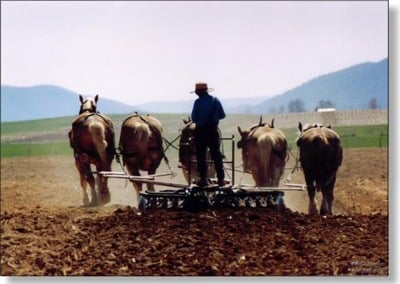




We’re all kind of set in our ways.
You know how to be the person you are. You've spent years developing the skills for navigating the kind of life you now have. You’ve had a lot of practice at it. Changing it would be difficult.
But suppose you could do it over. Suppose you were a small child again, young enough to easily learn whatever lifestyle you were surrounded by. Suppose you were being given up for adoption, and there are two possibilities:
Option 1: You are adopted by an Amish family and grow up Amish.
Option 2: You are adopted by a middle-class American family into a lifestyle of dizzying and insatiable consumption, social alienation and isolation, stress, depression, constantly rushed, rarely fulfilled, disconnected from family, barely knowing your own neighbors, blinded by myriad structural distractions from ever noticing the suffering of those oppressed by the systems that support your lifestyle, and burning through resources like there’s no tomorrow, which, at average US rates of pollution and resource depletion, there might not be.
Put that way, now which would you choose?
Do you value environmental protections and sustainability? Amish agriculture is extremely energy efficient. They use organic fertilizers that come from their own horses and cows. In dairy production,
“even the most efficient modern farms require 65% more energy per kilogram of milk”than an Amish dairy farm (Peterson 31).
Modern tilling disrupts the topsoil, and leads to more run-off, depleting the soil and polluting the water. No-till methods are spreading, but
“Amish hose plowing, it turns out, is better for the soil than [even] new no-till methods.”Because their farms are small compared to the vast monoculture farms of contemporary agribusiness, with crop rotation they can keep soil nutrients replenished and keep down pests. The Amish rarely use soil insecticides. Studies show that, yes, some Amish farms are ecologically questionable. But by and large
“there are real reasons to view Amish farming as a model for sustainable agriculture.”Their farms are comparatively small. They use little fossil fuel. The Amish do not accept government subsidies, so they don’t have to follow policies that encourage monocropping. They reject many of the newer farm technologies that help put other farmers into debt. The result is that Amish
“profits are higher per acre and per animal than conventional farms, and their debts and expenses are much lower.” (Peterson 30)The severe farm crisis of the 1980s never hit Amish farmers. While farm foreclosures were wiping out thousands of farmers, the Amish were doing just fine.
Rhonda Yoder’s 1990 study of Amish agriculture in Iowa concludes:
“In the midst of enormous economic instability, growing environmental dilemmas, and social upheaval (thousands of Iowa residents moving out of the state, countless farmers being forced out of farming and rural communities faced with decay), the Old Order Amish farmers and their communities were thriving. This type of success -- keeping farm families on the farm, building the fertility of the soil for the benefit of future generations and earning a living on small holdings – was a reality often dismissed as irrelevant in an era when agricultural leaders believed a farmer must ‘get big or get out.’ The Amish example defied this popular belief and demonstrated a viable alternative.” (Yoder 1)Put that way, now which would you choose?
Do you value social justice? Do you support ways to meet the needs of everyone and to care for the least well-off? In Amish communities,
“families take care of older and disabled members at home, never in institutions.... Amish [rules] prohibit both public insurance such as social security and private insurance policies because these would reduce members’ mutual dependence. For members, the community is its own insurance, and in times of need no one falls through the cracks.” (Peterson 37)There are some Amish who are wealthier than others, though overall the inequality is much less that in US society generally: the gap between the wealthiest and the poorest is much, much smaller. Indeed,
“the community has an informal claim on a wealthy Amishman’s resources. He is also protected from an all-out competition with other well-to-do families in purchasing and displaying the usual array of material status symbols. Prestige is also culturally tied in to the welfare of the community so that personal reputation can only reach fulfillment in the service of the kin and church community. The religious support for both cultural practices is strong teaching against high mindedness or pride and a conscious cultivation of the virtue of humility.” (Stoltzfus 312)They’re off the grid. They’re farming sustainably. They’re taking care of everyone.
Are they happy? It’s harder to measure that. What we can say is that they are succeeding, by their own standards of success.
* * *
This is part 2 of 4 of "The Amish Challenge"
Next: Part 3: "What Putting Community First Looks Like"
Previous: Part 1: "But apart from that..."
Sources
Peterson, Anna. Seeds of the Kingdom. 2005.
Stoltzfus, Victor. "Reward and Sanction: The Adaptive Continuity of Amish Life," Mennonite Quarterly Review 51, no. 4, October 1977.
Yoder, Rhonda Lou. "Amish Agriculture in Iowa: Indigenous Knowledge for Sustainable Small Farm Systems," Studies in Technology and Social Change, no. 15, Iowa State University, 1990.


No comments:
Post a Comment